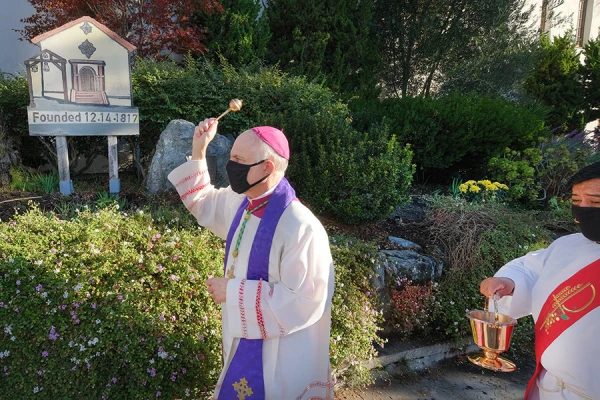
CNA Staff, Oct 20, 2020 / 02:42 am (CNA).- Archbishop Salvatore Cordileone of San Francisco on Saturday performed an exorcism at the site of a destroyed statue of St. Junipero Serra, calling the statue’s destruction by rioters an “act of blasphemy.”
“We pray that God might purify this place of evil spirits, that he might purify the hearts of those who perpetrated this blasphemy, that he might envelop them in his love, that their hearts might be softened and turn toward Him,” Cordileone said Oct. 17 before a crowd of about 150 people.
Serra, an 18th-century Franciscan priest and missionary, has been criticized by some activists as a symbol of colonialism and of the abuses that many Native Americans suffered after contact with Europeans. However, historians say Serra protested abuses and sought to fight colonial oppression.
A Oct. 12 protest at Mission San Rafael Archangel began peacefully but then turned violent, as participants defaced the statue of the saint with red paint before dragging it to the ground with nylon straps and ropes.
Cordileone offered exorcism prayers in Latin before sprinkling the site with holy water. The prayers Cordileone offered at the statue site are not the same as exorcism prayers offered by the Church if a person is believed to be the subject of demonic possession.
This marks the second time that Cordileone has performed an exorcism in connection with a destroyed statue of Serra. A crowd of about 100 people tore down a Serra statue in San Francisco’s Golden Gate Park the evening of June 19, and Cordileone offered exorcism prayers after that incident.
Archbishop Cordileone last week decried the “mob rule” that led to the statue of the saint being “mindlessly defaced and toppled by a small, violent mob.”
“There is no question that the indigenous peoples of our continent suffered under Europeans who came here and their descendants, especially after the mission era ended and California entered into the United States. But Fr. Serra is the wrong symbol of those who wish to address or redress this grievance,” Cordileone contended.
During the eighteenth century, Serra founded nine Catholic missions in the area that would later become California, and many of those missions would go on to become the centers of major California cities. Though Serra himself did not found Mission San Rafael, it owes its existence to Serra’s legacy.
Critics have lambasted Serra as a symbol of European colonialism and the erasure of Native culture, and have in recent years sought to remove monuments to him and change the names of streets or landmarks named for him.
San Francisco school district officials this month announced that 44 schools with “inappropriate” names will likely be renamed soon, with Junipero Serra Elementary School near the top of the list of names likely to be changed.
Serra’s defenders say that he was actually an advocate for native people, noting an episode of his life when he drafted a 33-point “bill of rights” for the Native Americans living in the mission settlements and walking all the way from California to Mexico City to present it to the viceroy.
While many Native peoples did suffer horrific abuse, an archaeologist told CNA earlier this year that activists tend to conflate the abuses the Natives suffered long after Serra’s death with the period when Serra was alive and building the missions.
Pope Francis canonized Serra in 2015 during a visit to the United States.
Catholics had rallied in a peaceful demonstration the evening of Oct. 13 at the former statue site, at which a priest encouraged forgiveness of those who destroyed the statue.
Father Kyle Faller, parochial vicar at the mission, led a rosary and a Litany of Reparation for the statue’s destruction, as well as the prayer to St. Michael the Archangel.
San Rafael police have arrested five women in connection with the statue’s destruction and charged them with felony vandalism; all five have been issued citations and released. The cases have been forwarded to the district attorney’s office for prosecution, police said last week.
The Oct. 12 protest was organized by members of the Coast Miwok tribe, though it is not clear whether those arrested for the vandalism are members of the tribe.
CNA attempted to contact Dean Hoaglin, chair of the Coast Miwok Tribal Council of Marin and one of the organizers of the Oct. 12 protest, for further information on the tribe and their reasons for opposing Serra, but did not receive a reply by press time.
The Coast Miwok people were the original inhabitants of what is today Marin and southern Sonoma Counties of California. The tribe gained federal recognition as the Federated Indians of Graton Rancheria in December 2000.
In 2008, the former bishop of Sacramento, Francis Quinn, apologized to the Coast Miwok tribe that the Spanish “tried to impose a European Catholicism on the natives.”
The vandalism in San Rafael is the latest in a series of attacks on churches and Catholic statues across the country this year. On July 11, a fire under investigation for arson gutted the 249-year-old Mission San Gabriel in Los Angeles, a mission church founded by St. Serra.
Eighty-three percent of Catholic likely voters are concerned about attacks on churches in recent months, according to a poll conducted Aug. 27 – Sept. 1 by RealClear Opinion Research in partnership with EWTN News.
If you value the news and views Catholic World Report provides, please consider donating to support our efforts. Your contribution will help us continue to make CWR available to all readers worldwide for free, without a subscription. Thank you for your generosity!
Click here for more information on donating to CWR. Click here to sign up for our newsletter.



Leave a Reply